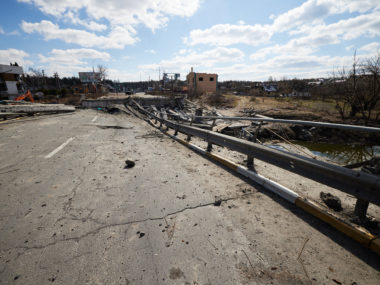By Christian Davenport and Scott Gates
Part 1 of this two-part series is here.
Misconception #3 – “The Domestic Conflict Field is a Mess”
The third reason for international conflict scholars ignoring the work of their domestic counterparts is that at first blush civil conflict appears a complex mix of activities, wrongfully put together in some overly-broad category. Under the civil conflict umbrella there are armed attacks, armed conflict, assassinations, civil war, counter-insurgency as well as terrorism, censorship, coups, disappearances, guerilla warfare, mass killing, political bans, protest, protest policing, restrictions on assembly, revolution, rioting, strikes, terrorism, and torture. The events are just one way of thinking about this diversity; it does not help if one considers the different labels that have been used to encompass several of them at once: e.g., “asymmetrical”/”one-sided” conflict, “domestic conflict”, “collective violence”, “civil strife”, “internal war”, “contentious politics”, “human rights”/”personal integrity” violations, “low intensity operations”, “negative sanctions”/”civil liberties restrictions”, “political instability”, and “small wars”.
Despite the differences in activities and labels (arguably which exist as different scholars attempt to make names for themselves), the field is no more divided than any other. In fact, the behavior of interest is actually less diverse than many would believe. Categorization, synthesis, and bringing together disparate types of conflict have actually been a major part of this research program. In some cases, however, the combinations have not actually been undertaken, but they are implied.
For example, confronted with the diversity in activities, earlier scholars tended to factor analyze many of the different events identified above in order to generate one or a few variables for subsequent examination (e.g., Tanter 1966; see Zimmerman [1980] for useful review). This work consistently yielded two factors: one which represents organized collective action (e.g., protest, civil war, and revolution) and one which represented less or non-organized collective action (e.g., riots, assassination, and armed attacks). Through a pattern-recognizing methodological technique, seeming diversity was thus reduced to specific dimensions.
The field eventually moved away from this type of examination/variable creation to explore the unique determinants and dynamics of the individual forms of conflict used to create the index (e.g., protest, strikes, armed attacks, and civil war viewed one at a time). Interestingly, in the last few years scholars have reflected, somewhat critically, about similar aggregations of data, drawing very different conclusions. For example, Kalyvas (2006) as well as Davenport and Stam (2003) argued that the possibility and validity of highly aggregated data at the nation-year is undermined by the complex interplay of localized vs. nationalized conflict dynamics as well as between public and private motives. Sometimes these overlap and sometimes they do not. In this view, different types of conflict are best thought of as a concatenation of more localized struggles that are placed together into a master narrative described simply as “civil war” (Kalyvas 2006) or “genocide” (Davenport and Stam 2003). While allowing for a wide variety of forms that domestic conflict can take, Kalyvas as well as Davenport and Stam still bring us back to a larger aggregation. McAdam et al. (2001) achieves a similar result but takes a different way to get there. Again, allowing for a diversity of forms that domestic conflict can take, and in line with Kalyvas as well as Davenport and Stam, this author maintains that underlying all of the individual forms are unique concatenations of explanatory mechanisms (e.g., brokerage, activation of organized specialists, and so on). Once again, from the many, theory reveals the degree to which and how they come together to form a broader whole.[1]
Another important distinction that provides some order to the seeming chaos of domestic conflict research is the distinction between state and non-state behavior. Largely convened within a context where governments around the world were under assault from diverse parts of their citizenry (the 1960s), conflict scholars of intrastate behavior have generally focused on the activities that challenge political authorities: e.g., demonstrations, riots, and insurgency/civil war. This predominate attention continues to this day. In response to the actions of the very same governments, the growth of the human rights movement, as well as the global normative concern with what governments do to their citizens, other scholars began to focus on the actions of states: e.g., restrictions on speech, association, and assembly, torture, and mass killing. Simultaneously with the development of the latter scholarship, researchers began to focus on the dynamic interaction between challenges (as those engaged in change making) and governments (as those engaged in system maintenance) – the so-called “conflict-repression nexus” (e.g., Hibbs 1973; Lichbach 1987; 1995; Francisco 1996; Moore 1998; 2000).
Unfortunately, the work in this community (in line with the predominate situation confronted in the US and the West) largely focused on only one type of activity: political protest and protest policing. This left other, more violent forms of domestic conflict unaddressed. Filling the void, other scholars then emerged, drawing upon work in international relations (e.g., Fearon and Laitin 2003). Unfortunately, however, this work ignored the lower-level state-challenger contests discussed within earlier research. This omission was crucial because the newer research drew erroneous conclusions about state-dissident interactions which poorly informed their work.
Some unpublished work is attempting to address this limitation by examining exactly how lower-level conflicts escalate into higher-level ones (e.g., Sambanis and Zinn 2002; Davenport et al. 2008). The intersection of the two literatures is especially important because it reveals that not only could disparate types of domestic conflict be brought together – unifying the field – but it should be done because it provides insight into problems that were not well understood.
A final body of work combines several types of intrastate conflict at once, generally of a large-scale nature. Recently, scholars have begun to focus on state violence directed against civilians (e.g., Valentino et al 2004). The key for these scholars is to discover when, in a civil war situation, governments are most likely to target civilians. While important, this research is limited because it ignores non-conflict situations. For example, civilians may generally be targeted by governments regardless of whether or not a civil war exists. In this context, there is nothing especially important about civil war but there is something important about governments that need to be addressed. Again, not only could one combine disparate types of domestic conflict together but it is clear that researchers should do this in order to improve understanding of the topic area.
Misconception #4 -“There is No Good Data on Civil Conflict”
We now consider our last misconception that prevents international conflict scholars from viewing and engaging with domestic conflict work. It is our contention that many in the former community are not familiar with the latter and those that are somewhat familiar do not believe that there is any decent data on the subject that can be used to examine diverse theoretical propositions. This is quite the opposite of the current situation. Indeed, in many respects, domestic conflict research is awash in data. At present, there are hundreds of databases, seemingly for every form of behavior: e.g., armed attacks, atrocities, civil liberties restrictions (limitations on speech, assembly and association), civil war, coups, demonstrations/protests, diverse personal integrity violations (e.g., torture, disappearance and mass killing), genocide/politicide, and terrorism. This said, it must also be acknowledged that the popular misconception is partly correct: much of the data that is available is of mixed quality. Rather than cover all aspects of domestic conflict, however, in this section we focus on one of the least popular forms: state repression. We do this in an effort to discuss the topic in a concrete manner as well as to familiarize the broader IR community with what is available.
Some Evils are Worse than Others. Given the number of people victimized by government coercive action throughout the world,[2] the wide range of legal, political, religious, and normative restrictions condemning such activity at local, national, and international levels, the number of social movements and human rights organizations that dedicated themselves to the elimination of this behavior, and the centrality of state coercion to socio-political theory (e.g., Weber, Hobbes, Machiavelli, Foucault; Giddens; Bay)[3], it is surprising that so little systematic attention has been given to the topic of repression – especially large-scale activity (McCamant 1984). This limitation is particularly noticeable when one looks at the amount of scholarship dedicated to non-state conflictual behavior such as revolution, terrorism (very recently), or contentious activities where the role of the state is downplayed or obscured such as civil war.
For example, over 80-100 quantitative studies of civil war have been produced in the last 10-15 years alone but the number of quantitative investigations dedicated to genocide over the last 30-40 years is merely a handful: Fein 1979; Rummel 1994; Krain 1997; Harff 2003; and Valentino et al. 2004; the number of investigations dedicated to torture equals one: Hathaway 2002. This is extremely disheartening because researchers have consistently argued that these activities have claimed the most lives (Rummel 1994; Armstrong and Davenport 2008).
The number of analyses increases significantly when we consider somewhat lesser violent forms of state repression such as negative sanctions and civil liberties restriction (e.g., Taylor and Jodice 1983; Davenport 1995; Moore 1998) or personal integrity violations (e.g., Mitchell and McCormick 1988; Poe and Tate 1994; Cingranelli and Richards 1999; Zanger 2000; Davenport and Armstrong 2004; Hafner-Burton 2005). Regardless of conceptualization and operationalization, the basic point is still clear: to date, researchers have simply paid far more attention to the evils done to states as well as citizens by dissidents, rebels, and terrorists than to the evils done by governments against those under their care.[4]
The State of Repression Data. Despite the relative amount of neglect shown to extremely violent state repression, over the last 40 years a thriving research program around this topic has emerged – albeit one that is not always aware of itself. This section attempts to provide a review of the different databases currently available.
Data: Documenting Arrests, Disappearances, and Mass Killing
Similar to most individuals in the field of conflict studies, repression scholars have generally taken two approaches to investigate the numerous hypotheses emerging from relevant literature. Some compile information on discrete events (e.g., Tilly 1978; Taylor and Jodice 1983; Koopmans 1995; Ball 1996; Beissinger 2002; Davenport and Stam 2003; SCAD; GDELT). These individuals identify how many times authorities arrest or execute citizens and impose curfews. Other researchers collect information but they place them into discrete categories, which represent some measure of lethality (e.g., Gurr 1993; Poe and Tate 1994; Hathaway 2002; Harff 2003). This work also relies upon events but rather than trying to precisely identify exactly how many times something occurred, they identify generally how much something has taken place as well as other characteristics that could not simultaneously be addressed within an event count (e.g., how many individuals were sanctioned and by how many different repressive activities, how lethal were all of the different actions applied, and how long did the aftereffect endure). This approach is useful for some events that are simply much worse than others in magnitude, scope and severity.
The general source of information on repression varies. Those interested in events have typically used newspapers (e.g., McAdam 1982; Soule and Davenport 2009) but more recent work has employed human rights records (e.g., Ball 1996; Davenport and Stam 2003) and government reports (e.g., Davenport and Stam 2003). In many respects, the use of these sources makes sense because it was commonly believed that they paid attention to the activities undertaken by authorities and especially those actions that were controversial as well as newsworthy. The selection also made sense because many of the researchers were specifically interested in behavior that targeted protestors engaged in anti-state activity – another controversial and newsworthy topic of interest (e.g., Taylor and Jodice 1983).
Of course, research has revealed that the perceptions about newspaper-generated data are not quite accurate (e.g., Jackman and Boyd 1979; Davenport and Ball 2002; Franzosi 2004; Ortiz et al. 2005). Subjecting these data to a battery of statistical examinations, three problems have been identified. First, there are “threshold” effects where only events above a certain level of significance receive coverage because of the rather large market that this would appeal to and the increased costs that are involved with finding smaller actions (e.g., Taylor and Jodice 1983, 179; Davenport 2009). Second, there are “fatigue” effects where only events that are short-term in duration receive coverage in an effort to establish as well as maintain consistent readership and again to hold costs down (e.g., Gerner and Schrodt 1996). Third, there are “newshole” effects where coverage is determined by the amount of available space within the pages of a newspaper.
Although the use of newswires (e.g., Francisco 1996) and local sources (e.g., Ortiz et al. 2005; Davenport 2009) overcomes some of these problems, in an effort to more completely overcome the identified limitations other scholars rely on organizations that are more specifically focused on repressive behavior and which use a different approach to discover who did what to whom; in particular, they use human rights reports compiled from eyewitness accounts. The information contained in these sources has proven to be extremely useful because unlike news organizations, they are directly and exclusively interested in state coercion. Additionally, these organizations have well developed networks of communication both within and across countries – referred to as the “curious grapevine” (Korey 2001).[5]
While an improvement on some of the issues that plague newspapers, the use of human rights records has unexpectedly led to a different problem. Given the interest of these sources, they do not provide any information about the behavior of ordinary citizens or those challenging the state. This is problematic because one of the principle explanations for repressive behavior concerns protest behavior and civil unrest. Measures for these activities still exist, but these tend to rely upon the same newspaper accounts that prompted the development of categorical data in the first place – a situation that is not ideal but allows for a certain degree of consistency in measurement. Indeed, what is needed is something equivalent to the human rights-oriented NGO but with an interest in dissent.
Other scholars employ government documents such as constitutions or laws (e.g., Keith 2002), regional and international documents (e.g., Hathaway 2002), randomly sampled surveys of national populations regarding their perceptions of rights protection, and, more recently, tweets.
Drawing upon the different sources above, numerous databases on state repression have been created.
First, there are global databases (e.g., Taylor and Jodice 1983; Krain 1997; Hathaway 2002; Harff 2003; Valentino et al. 2004; Uppsala Conflict Data Program 2005). These identify state repressive behavior within all countries of the world; the unit of analysis typically employed is the nation-year. While uniformly grouped under this category, distinct researchers/research teams focus on different types of activity and tend to ignore the others. For example, some focus on one type of repression: e.g., Harff’s data focuses on genocide/politicide, the Uppsala Conflict Data Program focuses on “one-sided” state violence, and Schrodt focuses on atrocities. Some databases focus on several activities at once in an index: e.g., Mitchell and McCormick (1988) as well as Cingranelli and Richards (1999) – all provide information on personal integrity violations combining torture, disappearances, mass arrests, and mass killing together whereas Freedom House combines information on restrictions of assembly, association, speech, and so forth. Others disaggregate the relevant concept, highlighting distinct tactics: e.g., Cingranelli and Richards (1999).
Second, there are regional databases (e.g., Francisco [2009] concerning protest policing in Europe). By reducing the sheer number of countries under examination, these efforts have endeavored to disaggregate space (identifying states, cities, and villages), time (identifying year, month, and day), actors (identifying perpetrators and victims) as well as actions (identifying categories of action, frequency, objectives, outcomes, and so forth).
Third, there are databases that consider a subset of countries from distinct regions unified by some criteria (e.g., Moore and Davis [2006] concerning various human and civil rights violations). These databases provide even greater disaggregations and facilitate more attention to diverse contextual factors.
Finally, there are single-case databases: e.g., Koopmans 1995; Beissinger 2002; Rwanda – Davenport and Stam 2003. These efforts have provided the greatest degree of disaggregation across both space and time, allowing analyses of who did what to whom by community, neighborhood, village, and city as well as by quarter, month, week, day, and hour.
Parting Shot
We have attempted to eliminate some of the reasons why international relations scholars do not read/argue with domestic conflict work by highlighting four misconceptions that block such consideration. We do this because we believe that only developing a conflict studies that unifies the two areas (i.e., inter- as well as intra-state conflict) will provide us with the theory, methods, and data to analyze and better understand the world around us. An important next step would move past misconceptions to identify blockages. Most important in this regard would be addressing the practice within the field to focus on very particular aspects of a problem and losing the less publishable forest for the highly publishable leaf on a tree. The step after that would address how to establish bridges between the fields, beyond the token article, chapter, or participation in a special issue, book, or conference panel. Indeed, we should now be pushing to identify the generalizability of our findings across all forms of conflict. Does democracy decrease all forms of conflict? Does economic development have an influence on diverse forms of conflict as much as it does on civil war and, if so, what does that influence mean? If the behavior of specific units matters, then how can this insight be brought across the different forms of conflict and how does it challenge/change our results (if at all)?
Scott Gates (scott@prio.no) is a Research Professor at the Peace Research Institute Oslo.
[1] In a way, this would be like researchers who focused on individuals battles working their way up to wars. There are many ways that wars are fought and the disaggregation of these processes might be useful for understanding what takes place. [2] By most accounts, the 20th century witnessed more individuals killed by the governments under whose care they have been place than others.
[3] States are commonly defined by their ability to wield coercive power.
[4] Clearly there is far more attention given to state coercive behavior. [5] While not all of these organizations compiled information in a manner that was appropriate for quantification and statistical analysis, most have now adopted the same techniques – thus improving as well as standardizing the process.




3 comments
Reblogged this on Half Glass of Water and commented:
Excellent article. It opens a door for discussion that is crucial for understanding political violence in general – seems like we forget that there are ties that bind different areas of political science, and in doing so, the loss is ours.